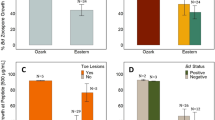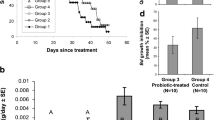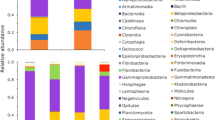Abstract
Many species of amphibians in the wet tropics of Australia have experienced population declines linked with the emergence of a skin-invasive chytrid fungus, Batrachochytrium dendrobatidis. An innate defense, antimicrobial peptides produced by granular glands in the skin, may protect some species from disease. Here we present evidence that supports this hypothesis. We tested ten synthesized peptides produced by Australian species, and natural peptide mixtures from five Queensland rainforest species. Natural mixtures and most peptides tested in isolation inhibited growth of B. dendrobatidis in vitro. The three most active peptides (caerin 1.9, maculatin 1.1, and caerin 1.1) were found in the secretions of non-declining species (Litoria chloris, L. caerulea, and L. genimaculata). Although the possession of a potent isolated antimicrobial peptide does not guarantee protection from infection, non-declining species (L. lesueuri and L. genimaculata) inhabiting the rainforest of Queensland possess mixtures of peptides that may be more protective than those of the species occurring in the same habitat that have recently experienced population declines associated with chytridiomycosis (L. nannotis, L. rheocola, and Nyctimystes dayi). This study demonstrates that in vitro effectiveness of skin peptides correlates with the degree of decline in the face of an emerging pathogen. Further research is needed to assess whether this non-specific immune defense may be useful in predicting disease susceptibility in other species.




Similar content being viewed by others
References
Alford RA, Richards SJ (1999) Global amphibian declines: a problem in applied ecology. Annu Rev Ecol Syst 30:133–65
Berger L, Speare R, Hyatt A (1999) Chytrid fungi and amphibian declines: overview, implications and future directions. In: Campbell A (ed) Declines and disappearances of Australian frogs. Environment Australia, Canberra, pp 23–33
Berger L, Speare R, Daszak P, Green DE, Cunningham AA, Goggin CL, Slocombe R, Ragan MA, Hyatt AD, McDonald KR, Hines HB, Lips KR, Marantelli G, Parkes H (1998) Chytridioycosis causes amphibian mortality associated with population declines in the rain forests of Australia and Central America. Proc Natl Acad Sci USA 95:9031–9036
Bosch J, Martinez-Solano I, Garcia-Paris M (2001) Evidence of a chytrid fungus infection involved in the decline of the common midwife toad (Alytes obstetricans) in protected areas of central Spain. Biol Conserv 97:331–337
Bowie JH, Wegener KL, Chia BCS, Wabnitz PA, Carver JA, Tyler MJ, Wallace JC (1999) Host defence antibacterial peptides from skin secretions of Australian amphibians. The relationship between structure and activity. Protein Peptide Lett 6:259–269
Bradley GA, Rosen PC, Sredl MJ, Jones TR, Longcore JE (2002) Chytridiomycosis in native Arizona frogs. J Wildl Dis 38:206–212
Carey C, Cohen N, Rollins-Smith L (1999) Amphibian declines: an immunological perspective. Dev Comp Immunol 23:459–472
Chia BC, Carver JA, Mulhern TD, Bowie JH (2000) Maculatin 1.1, an anti-microbial peptide from the Australian tree frog, Litoria genimaculata. Eur J Biochem 267:1894–1908
Chia BC, Carver JA, Mulhern TD, Bowie JH (1999) The solution structure of uperin 3.6, an antibiotic peptide from the granular dorsal glands of the Australian toadlet, Uperoleia mjobergii. J Pept Res 54:137–145
Conlon JM, Kolodziejek J, Nowotny N (2004) Antimicrobial peptides from ranid frogs: taxonomic and phylogenetic markers and a potential source of new therapeutic agents. Biochim Biophys Acta 1696:1–14
Daszak P, Berger L, Cunningham AA, Hyatt AD, Green DE, Speare R (1999) Emerging infectious diseases and amphibian population declines. Emerg Infect Dis 5:1–23
Donnellan SC, Mahony MJ (2004) Allozyme, chromosomal and morphological variability in the Litoria lesueuri species group (Anura:Hylidae), including a description of a new species. Australian Journal of Zoology 52:1–28
Doyle J, Llewellyn LE, Brinkworth CS, Bowie JH, Wegener KL, Rozek T, Wabnitz PA, Wallace JC, Tyler MJ (2002) Amphibian peptides that inhibit neuronal nitric oxide synthase: the isolation of lesueurin from the skin secretion of the Australian Stony Creek Frog Litoira lesueuri. Eur J Biochem 269:100–109
Houlahan JE, Findlay CS, Schmidt BR, Meyer AH, Kuzmin SL (2000) Quantitative evidence for global amphibian population declines. Nature 404:752–755
Kiesecker JM, Blaustein AR, Belden LK (2001) Complex causes of amphibian population declines. Nature 410:681–684
Laurance WF, McDonald KR, Speare R (1996) Epidemic disease and the catastrophic decline of Australian rain forest frogs. Conserv Biol 10:406–413
Lips KR (1999) Mass mortality and population declines of anurans at an upland site in western Panama. Conserv Biol 13:117–125
Lips KR, Reeve JD, Witters LR (2003) Ecological traits predicting amphibian population declines in Central America. Conserv Biol 17:1078–1088
Loehle C (2003) Competitive displacement of trees in response to environmental change or introduction of exotics. Environ Manage 32:106–115
Longcore JE, Pessier AP, Nichols DK (1999) Batrachochytrium dendrobatidis gen. et sp. nov., a chytrid pathogenic to amphibians. Mycologia 91:219–227
Maeji NJ, Bray AM, Valerio RM, Wang W (1995) Larger scale multipin peptide synthesis. Pept Res 8:33–38
McClanahan LJ, Baldwin R (1969) Rate of water uptake through the integument of the desert toad, Bufo punctatus. Comp Biochem Physiol 28:381–389
McDonald K, Alford RA (1999) A review of declining frogs in Northern Queensland. In: Campbell A (ed) Declines and disappearances of Australian frogs. Environment Australia, Canberra, pp 14–22
Miele R, Ponti D, Boman HG, Barra D, Simmaco M (1998) Molecular cloning of a bombinin gene from Bombina orientalis: detection of NF-kB and NF-IL6 binding sites in its promoter. FEBS Lett 431:32–38
Morehouse EA, James TY, Ganley ARD, Vilgalys R, Berger L, Murphys PJ, Longcore JE (2003) Multilocus sequence typing suggests the chytrid pathogen of amphibians is a recently emerged clone. Molec Ecol 12:395–403
Nicolas P, Mor A (1995) Peptides as weapons against microorganisms in the chemical defense system of vertebrates. Annu Rev Microbiol 49:277–304
Norris DO (1996) Vertebrate endocrinology, 3rd edn. Academic, San Diego
Norris K, Harper N (2004) Extinction processes in hot spots of avian biodiversity and the targeting of pre-emptive conservation action. Proc R Soc Lond B Biol Sci 271:123–130
Northern Queensland Threatened Frog Recovery Team (2001) Stream-dwelling rainforest frogs of the wet tropics biogeographic region of North-east Queensland recovery plan 2000–2004. Queensland Environmental Protection Agency [WWW document] URL http://www.deh.gov.au/biodiversity/threatened/recovery/rainforest-frogs/
Nutkins JC, Williams DH (1989) Identification of highly acidic peptides from processing of the skin prepropeptides of Xenopus laevis. Eur J Biochem 181:97–102
Pessier AP, Nichols DK, Longcore JE, Fuller MS (1999) Cutaneous chytridiomycosis in poison dart frogs (Dendrobates spp.) and Whites’s tree frogs (Litoria caerulea). J Vet Diag Invest 11:194–199
Raftery MJ, Waugh RJ, Bowie JH, Wallace JC, Tyler MJ (1996) The Structures of the frenatin peptides from the skin secretion of the Giant Tree Frog Litoria infrafranata. J Pept Sci 2:117–124
Resnick NM, Maloy WL, Guy HR, Zasloff M (1991) A novel endopeptidase from Xenopus that recognizes a-helical secondary structure. Cell 66:541–554
Retallick RW, McCallum H, Speare R (2004) Endemic infection of the amphibian chytrid fungus in a frog community post-decline. PLoS Biol 2:e351
Richards SJ, McDonald KR, Alford RA (1993) Declines in populations of Australia’s endemic tropical rainforest frogs. Pac Conserv Biol 1:66–77
Rollins-Smith LA, Reinert LK, Miera V, Conlon JM (2002c) Antimicrobial peptide defenses of the Tarahumara frog, Rana tarahumarae. Biochem Biophys Res Comm 297:361–367
Rollins-Smith L, Carey C, Longcore J, Doersam J, Boutte A, Bruzgal J, Conlon J (2002a) Activity of antimicrobial skin peptides from ranid frogs against Batrachochytrium dendrobatidis, the chytrid fungus associated with global amphibian declines. Dev Comp Immunol 26:471–479
Rollins-Smith L, Doersam J, Longcore J, Taylor S, Shamblin J, Carey C, Zasloff M (2002b) Antimicrobial peptide defenses against pathogens associated with global amphibian declines. Dev Comp Immunol 26:63–72
Rozek T, Waugh RJ, Steinborner ST, Bowie JH, Tyler MJ, Wallace JC (1998) The maculatin peptides from the skin glands of the tree frog Litoria genimaculata: a comparison of the structures and antibacterial activities of maculatin 1.1 and caerin 1.1. J Pept Sci 4:111–115
Rozek T, Wegener KL, Bowie JH, Olver IN, Carver JA, Wallace JC, Tyler MJ (2000) The antibiotic and anticancer active aurein peptides from the Australian Bell Frogs Litoria aurea and Litoria raniformis: The solution structure of aurein 1.2. Eur J Biochem 267:5330–5341
Simmaco M, Mangoni ML, Boman A, Barra D, Boman HG (1998) Experimental infections of Rana esculenta with Aeromonas hydrophila: a molecular mechanism for the control of the normal flora. Scand J Immunol 48:357–363
Speare R, Berger L (2000) Chytridiomycosis in amphibians in Australia. [WWW document] URL http://www.jcu.edu.au/school/phtm/PHTM/frogs/chyspec.htm
Steinborner ST, Bowie JH, Tyler MJ, Wallace JC (1997a) An unusual combination of peptides from the skin glands of Ewing’s tree frog, Litoria ewingi: sequence determination and antimicrobial activity. Aust J Chem 50:889–894
Steinborner ST, Currie GJ, Bowie JH, Wallace JC, Tyler MJ (1998) New antibiotic caerin 1 peptides from the skin secretion of the Australian tree frog Litoria chloris: comparison of the activities of the caerin 1 peptides from the genus Litoria. J Pept Res 51: 121–126
Steinborner ST, Wabnitz PA, Bowie JH, Tyler MJ (1996) The application of mass spectrometry to the study of evolutionary trends in amphibians. Rapid Commun Mass Spectrom 10:92–95
Steinborner ST, Waugh RJ, Bowie JH, Tyler MJ (1997a) New caerin antibacterial peptides from the skin glands of the Australian tree frog Litoria xanthomera. Part 2. Sequence determination using mass spectrometry and associated techniques. Rapid Commun Mass Spectrom 11:997–1000
Steinborner ST, Waugh RJ, Bowie JH, Wallace JC, Tyler MJ, Ramsay SL (1997b) New caerin antibacterial peptides from the skin glands of the Australian tree frog Litoria xanthomera. J Pept Sci 3:181–185
Thomas CD, Cameron A, Green RE, Bakkenes M, Beaumont LJ, Collingham YC, Erasmus BFN, de Siqueira MF, Grainger A, Hannah L, Hughes L, Huntley B, van Jaarsveld AS, Midgley GF, Miles L, Ortega-Huerta MA, Peterson AT, Phillips OL, Williams SE (2004) Extinction risk from climate change. Nature 427:145–148
Vanhoye D, Bruston F, Nicolas P, Amiche M (2003) Antimicrobial peptides from hylid and ranin frogs originated from a 150-million-year-old ancestral precursor with a conserved signal peptide but a hypermutable antimicrobial domain. Eur J Biochem 270:2068–2081
Wabnitz PA, Walters H, Tyler MJ, Wallace JC, Bowie JH (1998) First record of host defence peptides in tadpoles. The magnificent tree frog Litoria splendida. J Pept Res 52:477–481
Wake DB (1991) Declining amphibian populations. Science 253:860–861
Wegener KL, Brinkworth CS, Bowie JH, Wallace JC, Tyler MJ (2001) Bioactive dahlein peptides from the skin secretions of the Australian aquatic frog Litoria dahlii: sequence determination by electrospray mass spectrometry. Rapid Commun Mass Spectrom 15:1726–1734
Wegener KL, Wabnitz PA, Carver JA, Bowie JH, Chia BCS, Wallace JC, Tyler MJ (1999) Host defence peptides from the skin glands of the Australian Blue Mountains tree-frog Litoria citropa: Solutions structure of the antibacterial peptide citropin 1.1. Eur J Biochem 265:627–637
Weldon C, du Preez LH (2004) Decline of the Kihansi Spray Toad, Nectophrynoides asperginis, from the Udzungwa Mountains, Tanzania. FROGLOG 62:2–3
Williams S, Bolitho E, Fox S (2003) Climate change in Australian tropical rainforests: an impending environmental catastrophe. Proc R Soc Lond B Biol Sci 270:1887–1892
Williams S, Hero JM (1998) Rainforest frogs of the Australian wet tropics: guild classification and the ecological similarity of declining species. Proc R Soc Lond B 265:597–602
Wong H, Bowie JH, Carver JA (1997) The solution structure and activity of caerin 1.1, an antimicrobial peptide from the Australian green tree frog, Litoria splendida. Eur J Biochem 247:545–557
Woodhams DC, Alford RA (2005) Ecology of chytridiomycosis in rainforest stream frog assemblages of tropical Queensland. Conserv Biol (in press)
Woodhams DC, Alford RA, Marantelli G (2003) Emerging disease of amphibians cured by elevated body temperature. Dis Aquat Organ 55:65–67
Zasloff M (2002) Antimicrobial peptides of multicellular organisms. Nature 415:389–395
Acknowledgements
Ethical approval (A699_01) for all surveys and experiments was granted from James Cook University, and the following permits were granted: Scientific Purposes Permits and Take, Use, Keep or Interfere with Cultural or Natural Resources Permits WISP00443102, WITK00441702, F1/000375/01/SAA, Wildlife Movement Permit WIWM00525702 from the Environmental Protection Agency and Queensland Parks and Wildlife Service; and Department of Natural Resources permits to collect biological or geological material from Queensland state forest, timber reserves and other state lands #1733. This research was supported by subcontracts to L.R.-S. and R.A.A. from an NSF Integrated Research Challenges in Environmental Biology grants IBN-9977063 and DEB-0213851 (James Collins, P.I.) and NSF grant IBN-0131184 to L.R-S. D.C.W. was supported by a Doctoral Research Scholarship, Supplementary Internal Research Account Scholarship, and International Post-Graduate Research Scholarship from James Cook University, a Grant-in-Aid of Research from the National Academy of Sciences administered by Sigma-Xi, The Scientific Research Society, and the Immunobiology of Blood and Vascular Systems Training Program (NIH 5 T32 HL069765-02). We are grateful for the generous donation of peptides from Dr. John Bowie and helpful discussion about the manuscript. We thank Dr. Elizabeth Davidson and Verma Miera for isolation of the VM1 isolate of B. dendrobatidis. For field assistance, we thank Sara Townsend and volunteers: Brian Brinkman, Jasmine Cauchi, Kathryn Lewthwaite, Fiona Marshall, Esther Mitchell, Thor Sawin, and Kendall Trudgen.
Author information
Authors and Affiliations
Corresponding author
Additional information
Communicated by Libby Marschall
Rights and permissions
About this article
Cite this article
Woodhams, D.C., Rollins-Smith, L.A., Carey, C. et al. Population trends associated with skin peptide defenses against chytridiomycosis in Australian frogs. Oecologia 146, 531–540 (2006). https://doi.org/10.1007/s00442-005-0228-8
Received:
Accepted:
Published:
Issue Date:
DOI: https://doi.org/10.1007/s00442-005-0228-8




